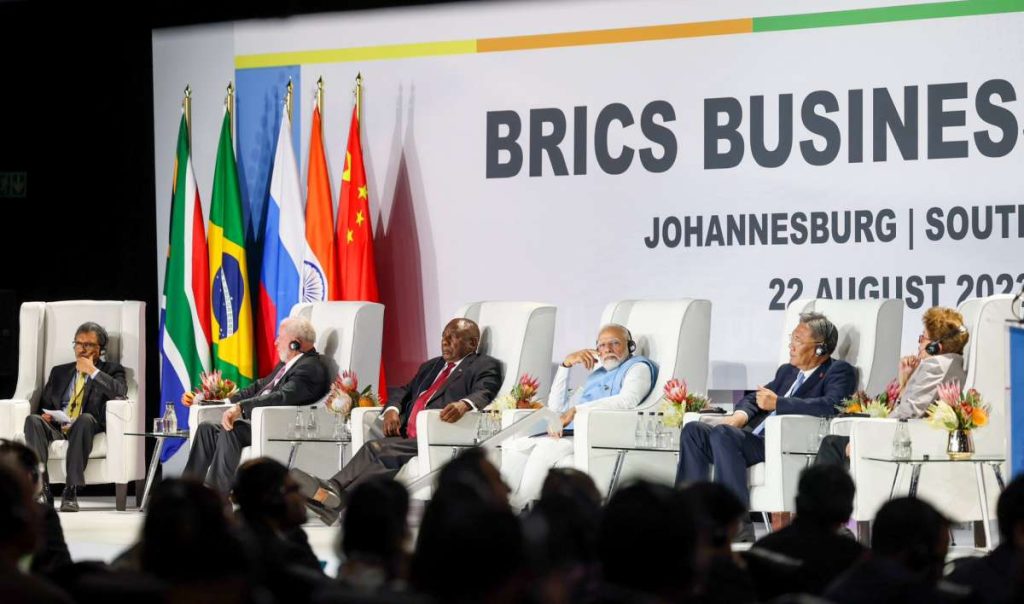Brazil’s President Lula da Silva reignited talk about a BRICS currency when he said that the currency would be used to facilitate trade between the emerging nations…reports Asian Lite News
As the 15th BRICS summit gets underway in Johannesburg, South Africa, the prospect of a common currency for the bloc continues to generate interest both inside and outside the bloc, even as key voices attempt to redirect the conversation towards trade and bond issuances in local currencies.
On Tuesday, Brazil’s President Lula da Silva reignited talk about a BRICS currency when he defended the idea, saying on a livestream that the currency would not be aimed at “rejecting” the U.S. dollar, but would instead be used to facilitate trade between the emerging nations.
“We want BRICS to be a multilateral institution, not an exclusive club,” Lula said, adding that the bloc should not be seen as a challenger to the existing power structure. “We do not want to be a counterpoint to the G7, G20 or the United States,” Lula said. “We just want to organize ourselves.”
In April, Lula said during a speech that he wants to see the establishment of a BRICS currency. “I am in favor of creating, within the BRICS, a trading currency between our countries, just like the Europeans created the euro,” Lula said.
But other BRICS members are resisting the common currency narrative. On Monday, Indian Foreign Secretary Vinay Mohan Kwatra delivered a special briefing to the media in which he downplayed the prospect of the BRICS countries developing a common currency to rival the U.S. dollar.
“The substantive part of trade and economic exchanges and discussions that have been a part of BRICS discussions, have so far, in a major way, focused on how to increase trade in respective national currencies,”Kwatra said, adding that this “is considerably different from a common currency concept.”
Kwatra added that “common currency discussions have several prerequisites,” which would need to be met before discussions about a common currency framework could even begin. “The discussion framework in BRICS and the substance of that discussion framework in BRICS have focused principally on trade within national currencies,” he said.

Kwatra is the latest senior official from within the bloc to attempt to rein in the runaway speculation of an imminent BRICS currency which began after the Russian embassy in Kenya posted a tweet to that effect on July 3.
The tweet, which was not formally endorsed by any other official or institution within the Russian Federation, was still used as the basis for multiple stories by Russian state-backed broadcaster RT that the common currency was in development, would be backed by gold, and would be announced at the August summit.
The Indian Foreign Minister’s comments echo those of Anil Sooklal, South Africa’s ambassador to BRICS, who told reporters on behalf of the host nation on July 20 that a BRICS currency announcement is not in the cards at the Aug. 22-24 summit.
“There’s never been talk of a BRICS currency; it’s not on the agenda,” he said during a media briefing. “What we have said, and we continue to deepen, is trading in local currencies and settlement in local currencies.”
The ambassador added, however, that the bloc’s member countries will continue to move away from the U.S. dollar, and that Western sanctions against Russia imposed after the Ukraine invasion are accelerating the transition.
“BRICS started a process that has been expedited as a result of the conflict, as a result of unilateral sanctions,” Sooklal said. “The days of a dollar-centric world is over; that’s a reality. We have a multipolar global trading system today.”
Even as China and India have pushed for the increased use of local currencies among bloc members, and the yuan and rupee in particular, other members see a strong incentive to back a common currency among BRICS nations.
In addition to the Brazilian leader, Sergey Lavrov, Russia’s Foreign Minister, has been very emphatic in his comments about the need for a common currency.
“Serious, self-respecting countries are well aware of what is at stake, see the incompetence of the ‘masters’ of the current international monetary and financial system, and want to create their own mechanisms to ensure sustainable development, which will be protected from outside dictates,” Lavrov told reporters following a meeting with Angolan President Joao Lourenco on Jan. 25.
“It is in this direction that the initiatives that have been voiced recently … about the need to think about creating our own currencies within the framework of BRICS.”
The BRICS’ answer to the IMF and the World Bank, the New Development Bank (NDB), is currently led by former Brazilian president Dilma Rousseff, who came from the same party as Lula and is believed to share his vision of economics and the global order.
However, Leslie Maasdorp, Vice President and Chief Financial Officer of New Development Bank, also pushed back against the common currency narrative in an interview with Bloomberg on July 5, and reaffirmed the centrality of national currencies in the Bank’s plans.
“The first point to make is that the New Development Bank has the U.S. dollar as its anchor currency,” Maasdorp said. “Our balance sheet is in U.S. dollars. We are firmly embedded in the U.S. dollar hemisphere.”

Leave a Reply